Pickleball Terms: The Must-Have Comprehensive Guide
Pickleball From A To Z
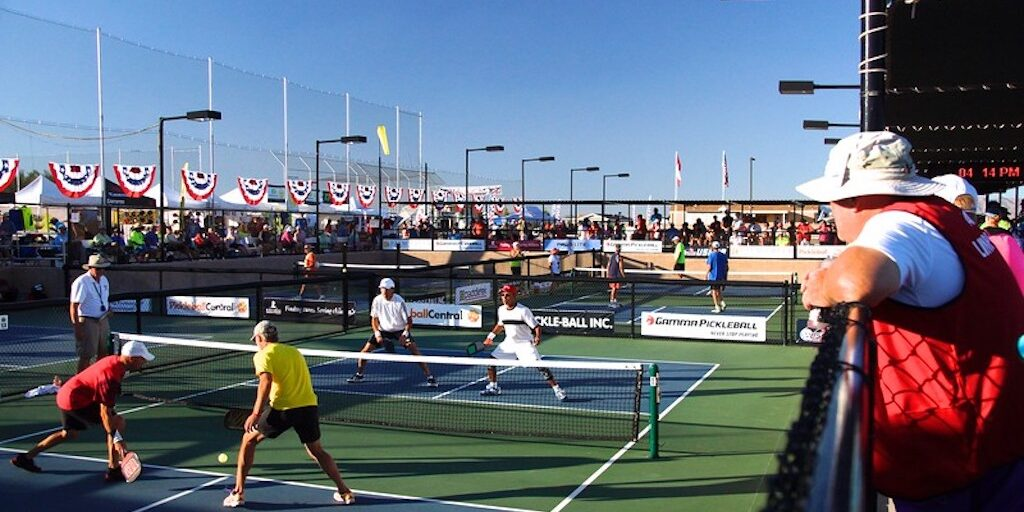
We did the research to be able to make this bold claim: here's the most comprehensive pickleball glossary on the internet.
The Most Comprehensive List of Pickleball Terms & Definitions:
A for Ace
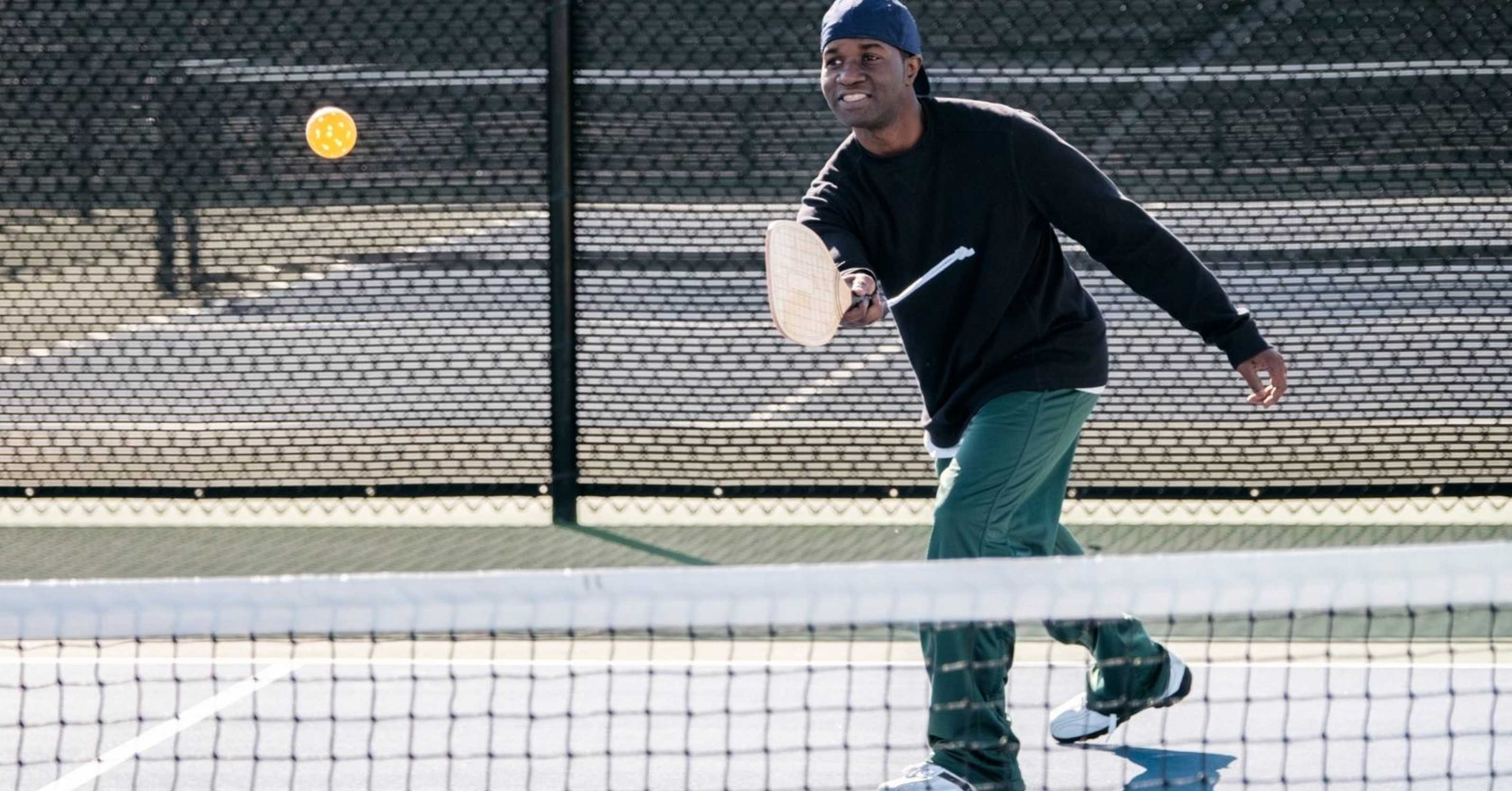
Ace: A serve that is untouched by the receiving team, resulting in an immediate point for the server.
Approach shot: A shot played by a player approaching the non-volley zone, setting up a favorable position near the net.
ATP (Around the Post): A shot where the ball is hit around the outside of the net post, usually from an extreme angle.
B for Backcourt
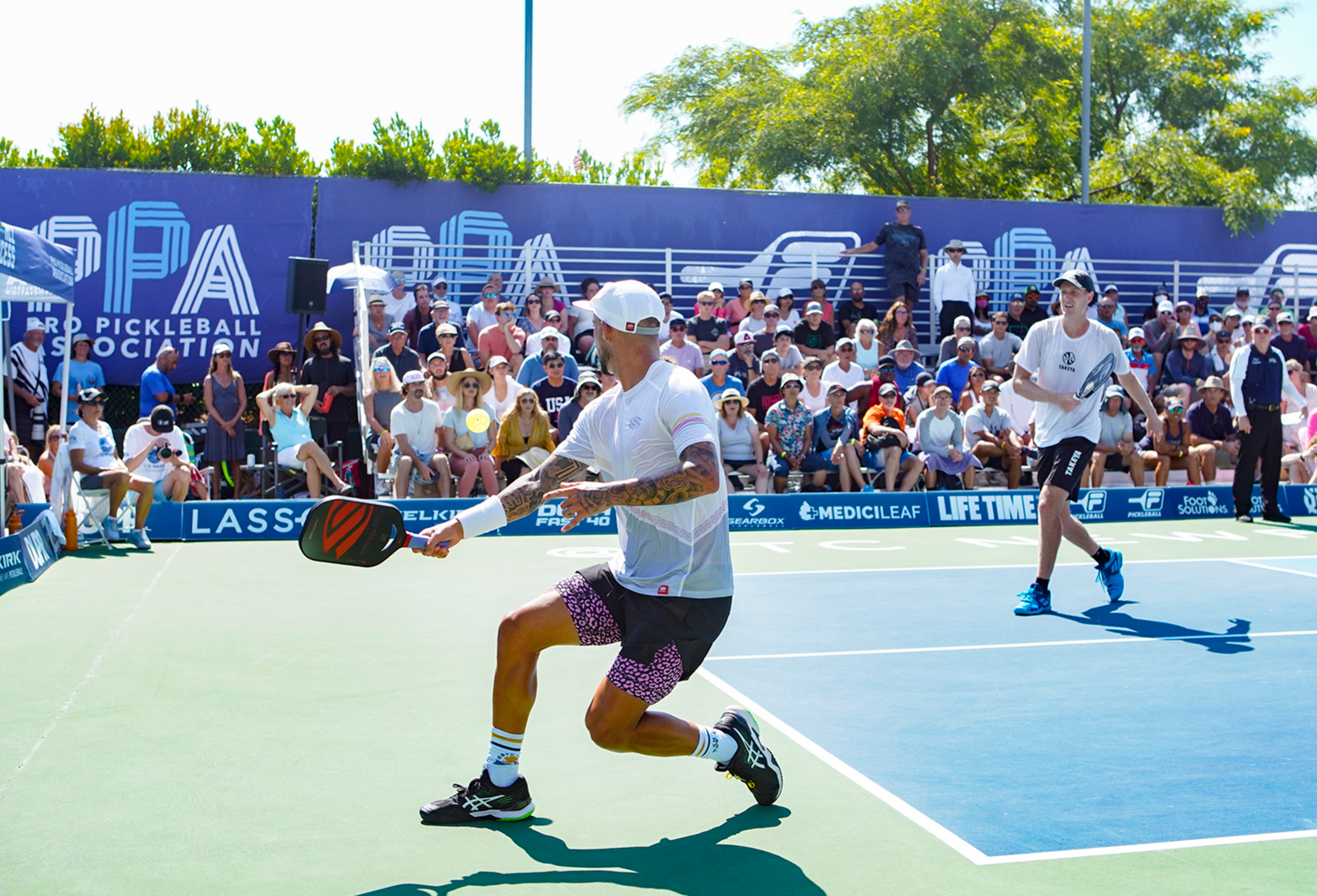
Backcourt: The area of the court located behind the non-volley zone (kitchen), where players typically position themselves to hit shots from a deeper position on the court.
Backspin: A type of spin that creates backward rotation and increases control. It causes the ball to rotate backward as it moves through the air. When a shot has backspin, the ball will have a higher trajectory and slower speed, with reduced bounce after it lands. Backspin is often used to create a shot with more control and accuracy, allowing players to place the ball precisely and minimize the opponent's ability to attack.
Backswing: The backward motion of the paddle and arm before swinging forward to hit the ball.
Backhand: A shot played with the paddle on the non-dominant side of the body, typically executed by hitting the ball across the body from the opposite side.
Banger: A player who consistently hits hard and powerful shots, often trying to overpower their opponents.
Baseline: The boundary line at the back of the court, parallel to the net. It marks the farthest limit of the playing area and separates the in-bounds area from out-of-bounds.
"Bounce It": A phrase often used in pickleball as a reminder or strategy to let the ball bounce before hitting it. It is a common reminder for players to allow the ball to bounce on their side of the court after the opponent's shot, as per the two-bounce rule, before hitting it back. The phrase serves as a reminder to avoid volleying the ball directly out of the air and to maintain adherence to the rules of the game.
C for Chop
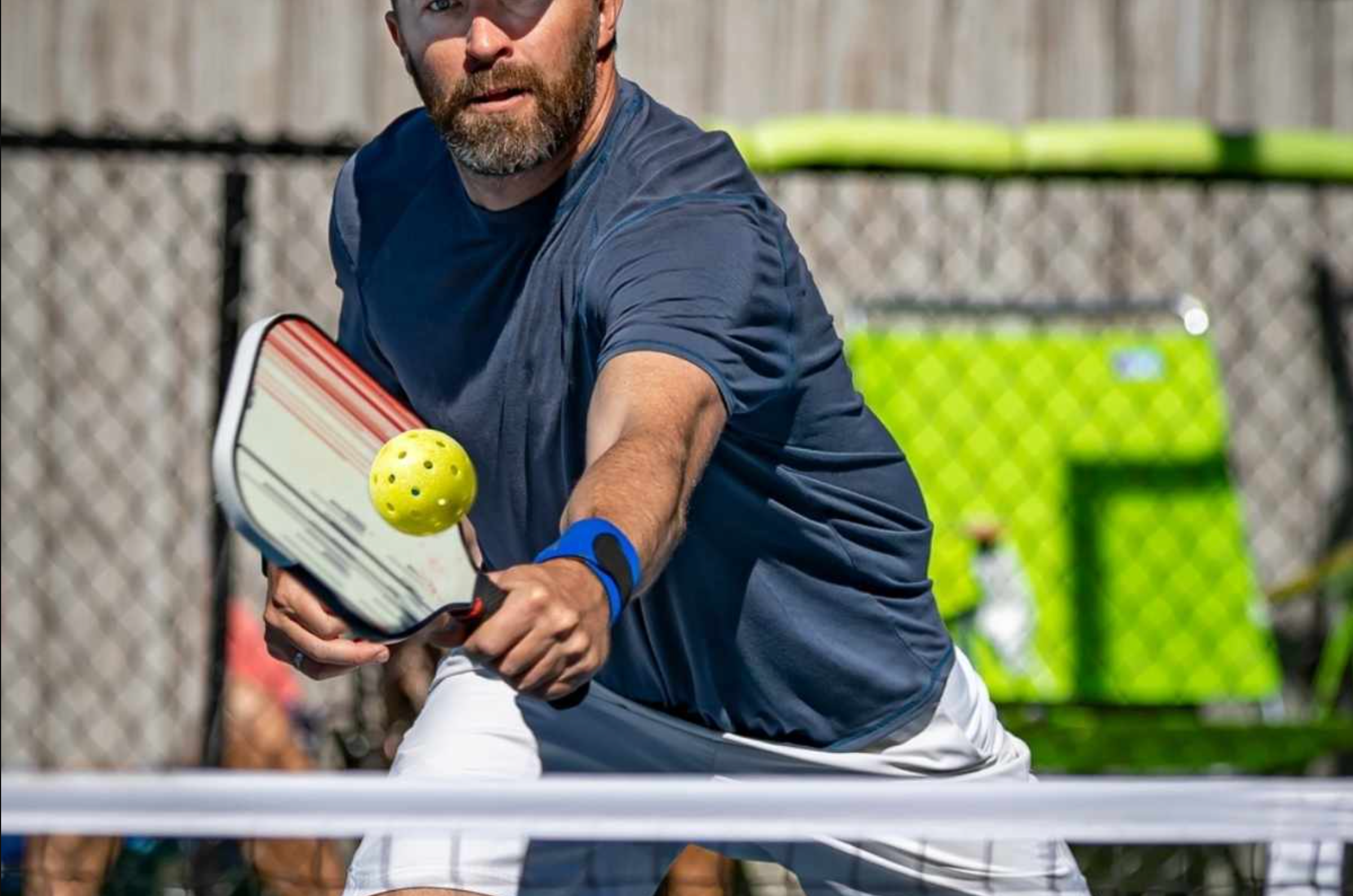
Carry: Refers to an illegal stroke where the ball is not cleanly struck and remains on the paddle momentarily, giving the impression of being carried or lifted. Carrying the ball violates the rule that requires the ball to be hit cleanly without excessive contact or prolonged contact with the paddle. A carry is considered a fault, and the point is awarded to the opposing team.
Centerline: The line that divides the court into two equal halves. It extends from the non-volley zone (kitchen) to the baseline and runs perpendicular to the sidelines. The centerline is used for determining certain rules and positioning during play, such as when serving diagonally or when moving between the different areas of the court.
Champion Shot: A pickleball shot that bounces twice in the non-volley zone.
Chop: A shot played with a downward and slicing motion, typically executed with backspin or underspin. It involves striking the ball with an angled paddle face, causing the ball to travel low and with reduced speed. The chop is often used as a defensive shot to keep the ball low over the net and create difficulty for the opponent in returning the shot.
Cross-court: Hitting the ball diagonally across the court from one side to the opposite side. It involves aiming the shot from one corner of the court towards the corresponding corner on the other side. The cross-court shot is commonly used to change the direction of play, create wider angles, or exploit gaps in the opponent's positioning. It can be an effective strategy to keep the opponent off balance and create opportunities for winners or strategic placement of the ball.
D for Dink
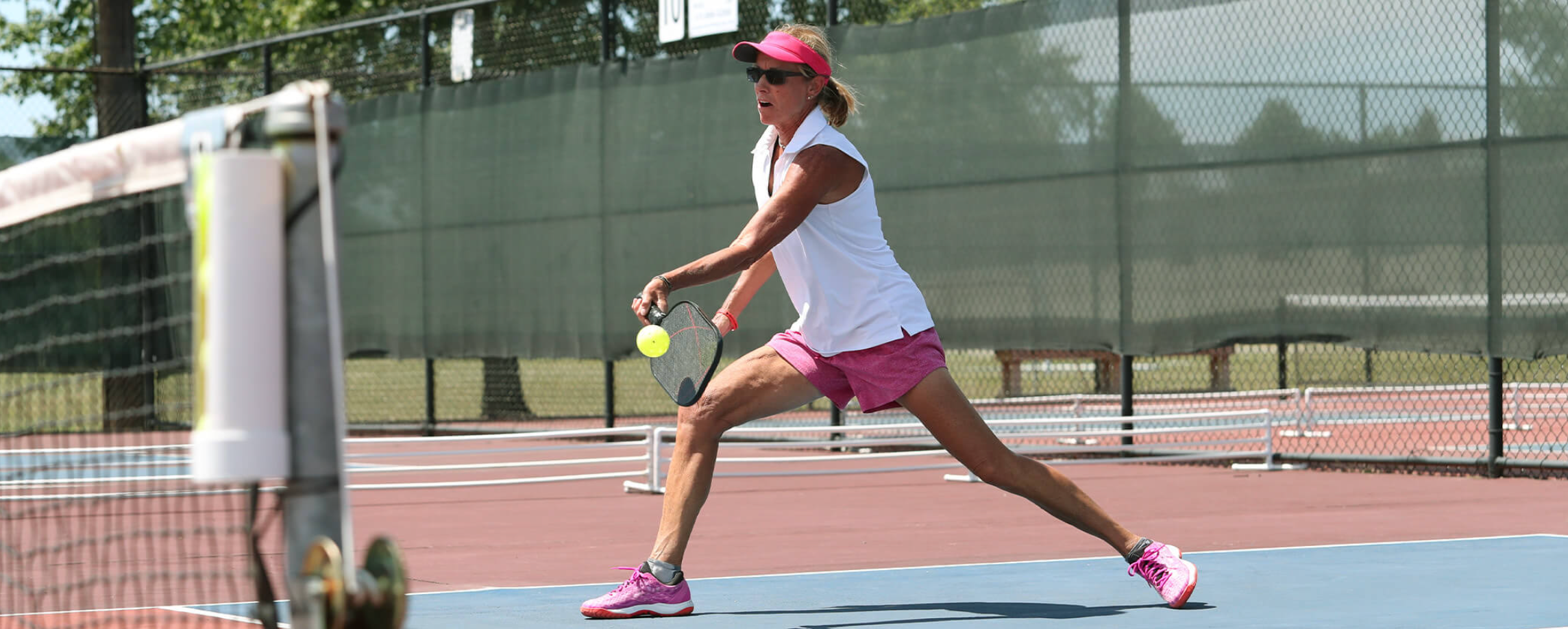
Dead ball: A ball that has lost its bounce or speed, typically due to a mishit or other factors. A dead ball is often easier to return as it lacks the liveliness and speed of a properly struck ball. Players may use the term "dead ball" to communicate to their partner or to describe a shot that will require less effort to handle.
Dig: A defensive shot in which the offensive power of a shot is absorbed and the ball is "reset" into the non-volley zone as an "unattackable" ball.
Dillball: A shot that is inbounds and has bounced once; a live ball.
Dink: A soft shot hit close to the net, usually with the intention of forcing the opponent to hit a similar shot.
Dinking Battle: An exchange of soft shots near the net, with players trying to outmaneuver each other.
Dinking Game: A strategic style of play that involves placing soft shots in the kitchen or opponent's half to set up advantageous positions.
Doubles: A format of play where two teams, each consisting of two players, compete against each other. Teams can be made up of men, women, or mixed doubles. It is a popular variation of the sport where teamwork, communication, and strategic positioning are crucial. In doubles play, each team has one player serving and the other player positioned at the non-volley zone (kitchen) or elsewhere on the court. Doubles matches are often fast-paced and involve dynamic shot-making and effective coordination between partners.
Double bounce: A rule in pickleball that requires the ball to bounce once on each side of the net at the start of a point. According to the double bounce rule, the serving team must allow the return of serve to bounce before hitting it, and the receiving team must let the served ball bounce as well. Once both sides have allowed the ball to bounce, the rest of the point can be played without the requirement of a bounce. The double bounce rule encourages longer rallies and provides an opportunity for players to set up strategic shots and maneuvering.
Double hit: An illegal stroke where a player hits the ball twice in succession with their paddle without the ball touching another surface in between. It occurs when a player makes contact with the ball and then unintentionally or intentionally hits it again before it has a chance to bounce or touch any other part of their body or equipment. A double hit is considered a fault, and the point is awarded to the opposing team.
"Down the Line": Hitting the ball straight and parallel to the sideline, aiming for the farthest corner of the opponent's court. It involves hitting the ball in a linear path that follows the sideline, rather than hitting diagonally across the court or cross-court. Hitting the ball down the line can be an effective strategy to create a direct and efficient shot, catch the opponent off-guard, or exploit open spaces in their court.
Drive: A fast and powerful shot hit with a flatter trajectory, typically used to put pressure on the opponent or hit winners.
Drop shot: A shot hit softly and close to the net, designed to land just over the net and fall sharply, making it difficult for the opponent to reach.
Drop shot volley: A soft and delicate shot played with a volley technique, typically executed near the non-volley zone (kitchen). It involves gently tapping or dropping the ball over the net, with the intention of landing the ball close to the net on the opponent's side. The drop shot volley is often used to surprise the opponent, disrupt their positioning, and force them to hit a difficult shot from a disadvantaged position. It requires good touch, finesse, and precise control of the paddle to execute effectively.
Drop spin: Applying backspin or underspin to a drop shot. It involves hitting the ball softly and with a downward motion while imparting spin that causes the ball to rotate backward or downward upon landing. The drop spin shot is effective in making the ball bounce lower and closer to the net, making it challenging for the opponent to return with pace or depth. The combination of a drop shot and spin adds an additional element of difficulty and can catch opponents off guard.
Dura: Referring to Dura Fast 40, which is the most commonly used type of pickleball ball in official tournaments and competitive play.
E for Erne (pronounced "Ernie")
Erne: A shot where a player quickly jumps out of bounds to hit a ball that would typically be out of reach in the non-volley zone.
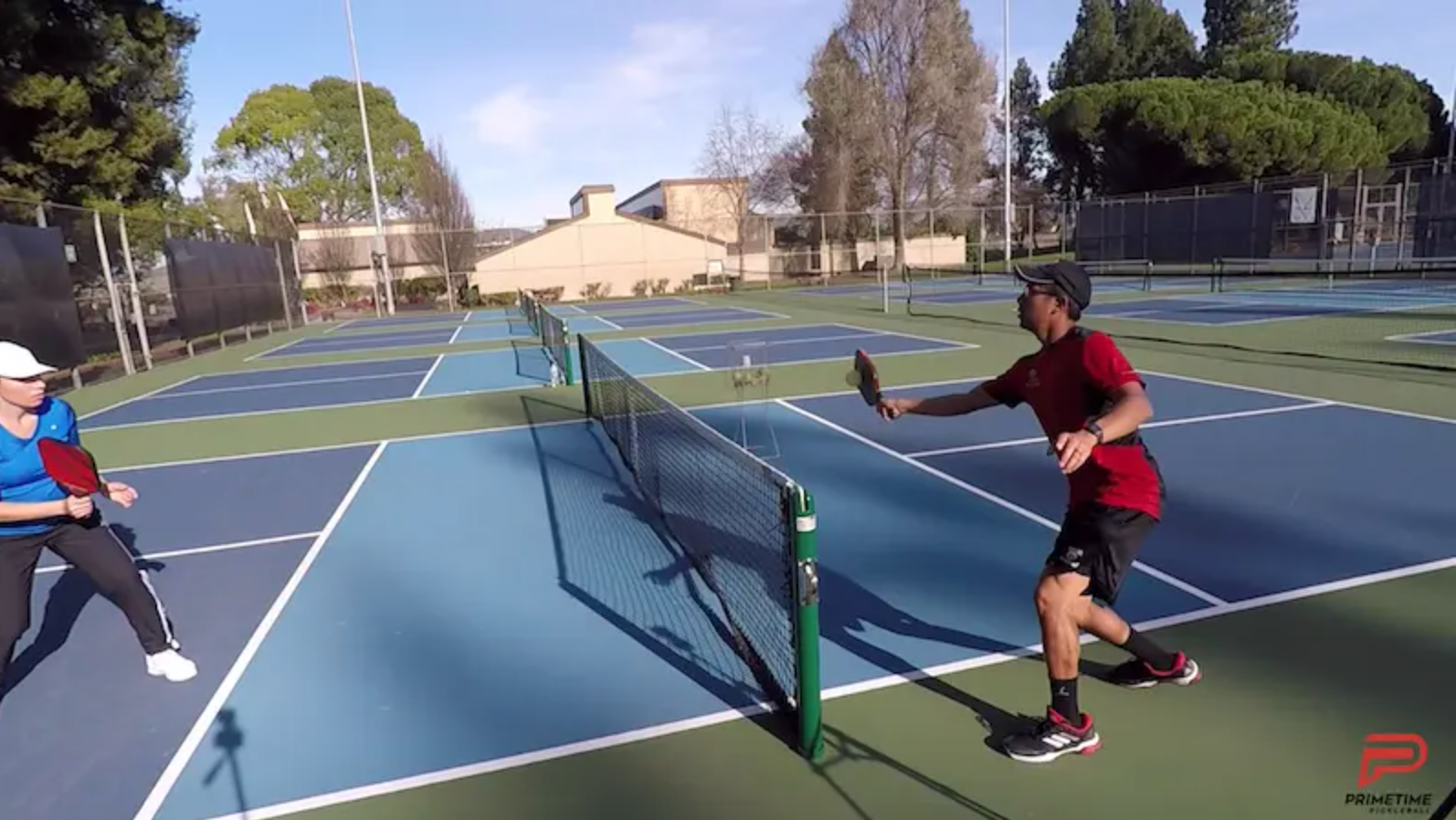
F for Face
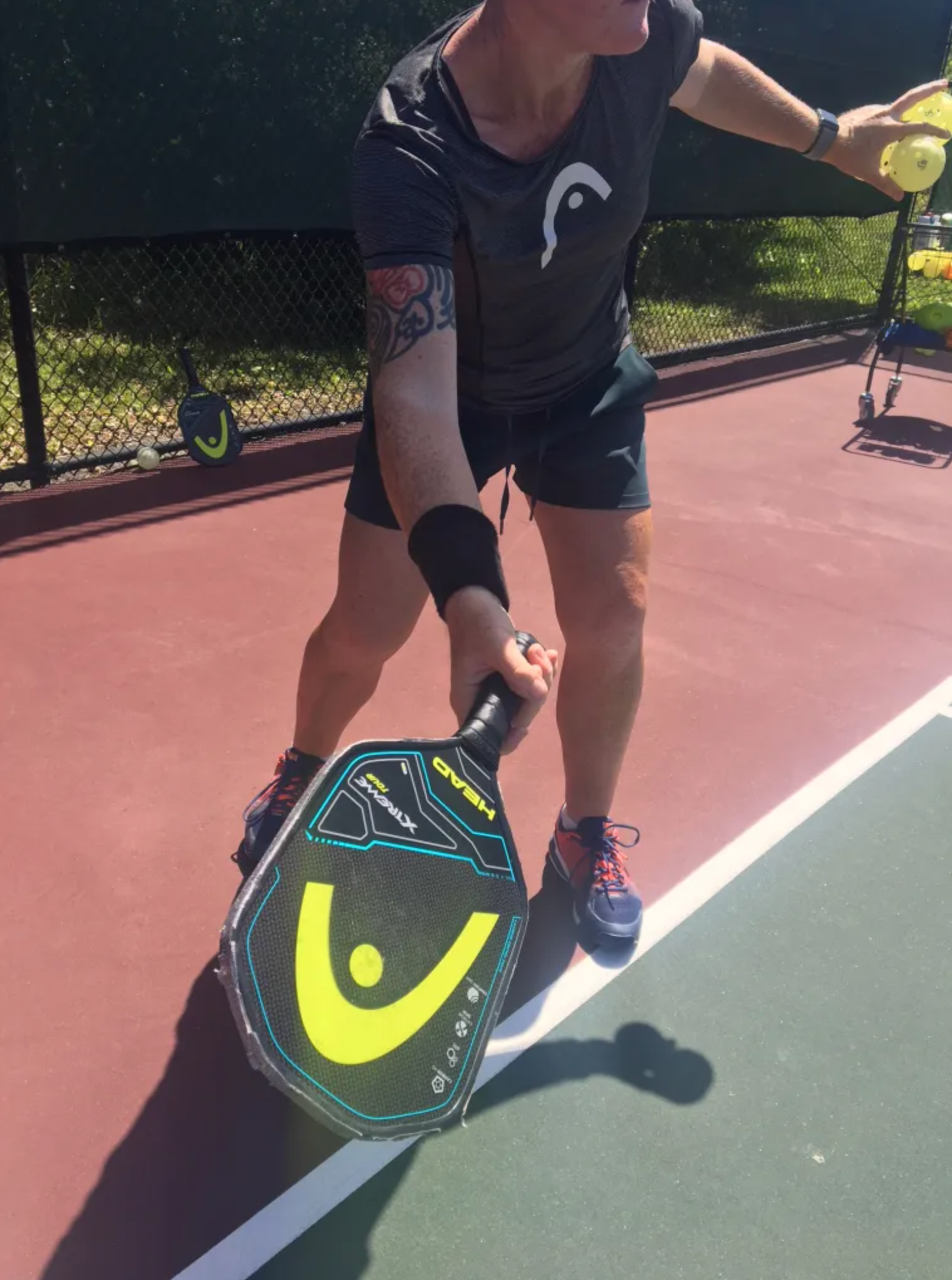
Face: The hitting surface of the paddle. The face is the part of the paddle that comes into contact with the ball during a shot. It is typically made of a smooth material, such as composite materials or wood, and may have a textured or patterned surface for improved ball control and spin generation. The face of the paddle is where players strike the ball to execute shots with various techniques and strategies.
Falafel: A "dead paddle" or a short shot due to hitting the pickleball ball with little or no power.
Fault: A serve that does not land in the correct service court or violates other serving rules.
Flabjack: A midair pickleball shot that must bounce once before it can be hit during one of the first two shots that of any point. After the third shot, players are allowed to volley the ball without the need of a bounce.
Flat face: A type of paddle face design. A paddle with a flat face has a smooth surface without any texture or pattern. The face is generally flat and uniform, providing a consistent striking surface for the ball. Paddles with a flat face are commonly used in pickleball and offer a balanced combination of control and power. The absence of texture on the face allows for a smoother contact with the ball during shots.
Follow through: The continuation of the forward paddle swing motion after making contact with the ball. It is the extension of the paddle and arm towards the target or desired direction of the shot. A proper follow through involves a smooth and fluid motion that allows the player to maintain control, generate power, and direct the ball accurately. A complete follow through helps with shot placement, spin generation, and overall shot execution.
Foot fault: When the server's feet touch or cross the baseline or sideline before making contact with the ball during a serve.
Footwork: The movement and positioning of a player's feet to reach and hit the ball effectively.
Forehand: Hitting the ball with the paddle on the dominant side of the body, typically executed by hitting the ball across the body from the same side. For right-handed players, the forehand shot is played on the right side of the body, while for left-handed players, it is played on the left side. The forehand is one of the primary shots used in pickleball and is generally more comfortable and powerful for players on their dominant side.
G for Game
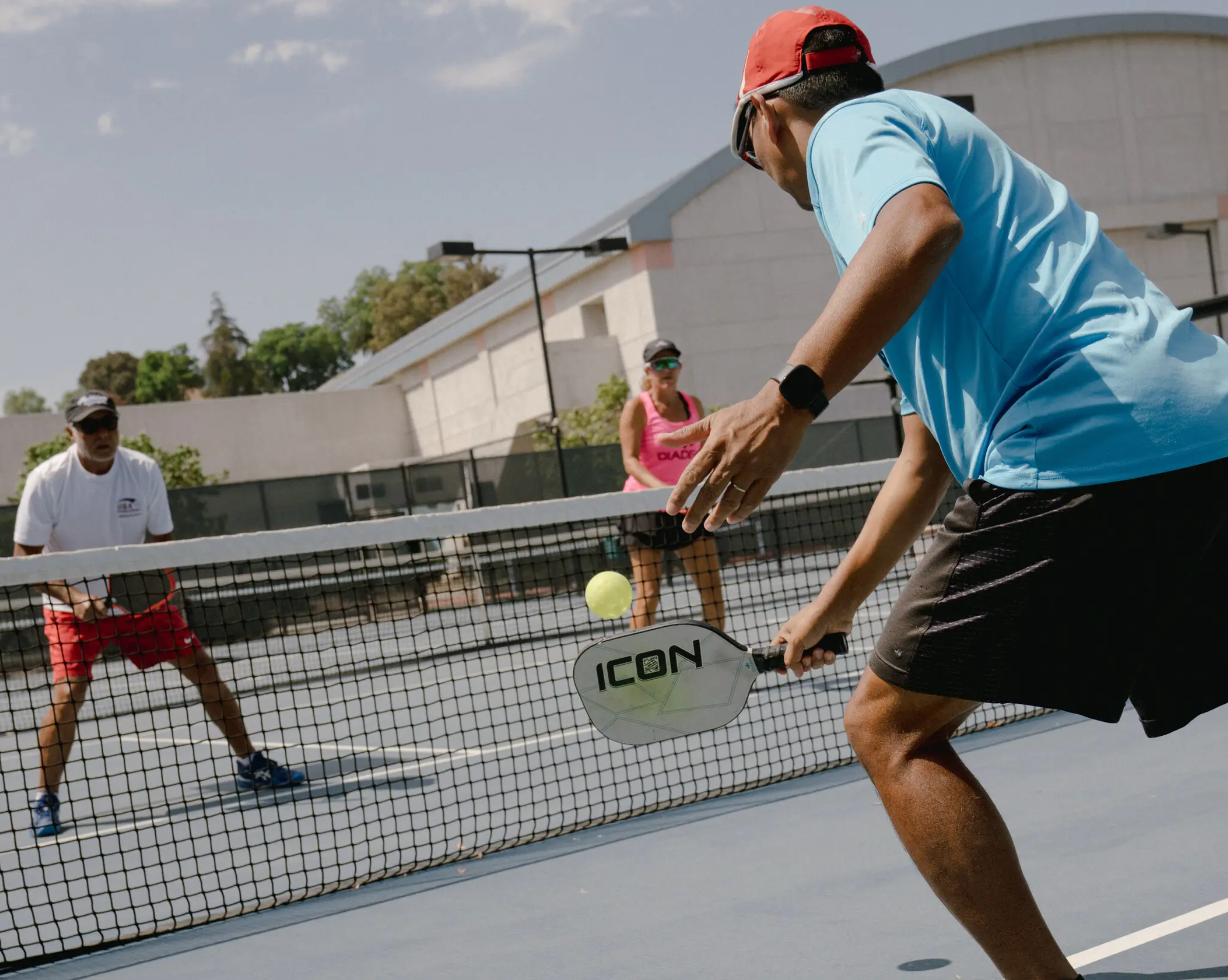
Game: Refers to a complete unit of play that consists of multiple points. A game is typically played to a certain number of points, often 11 or 15, depending on the agreed-upon rules or scoring system. Players or teams compete to score points by successfully hitting the ball over the net and into the opponent's court, following the rules and aiming to outscore their opponents. The first player or team to reach the predetermined number of points, with a minimum lead of two points, wins the game.
Grip: refers to how a player holds the paddle in their hand. The grip is a crucial aspect of technique and control in executing shots. There are several common grip styles used in pickleball, including:
-
Continental Grip: The paddle handle is held diagonally across the palm, with the base knuckle of the index finger resting on the bevel between the back and side of the paddle. This grip allows for versatility in hitting different types of shots.
-
Eastern Forehand Grip: The paddle handle is held more towards the right (for right-handed players) or left (for left-handed players) side of the palm, with the base knuckle of the index finger placed on the third bevel. This grip is suited for forehand shots and provides power and stability.
-
Eastern Backhand Grip: Similar to the Eastern Forehand Grip, but with a slight adjustment of the hand towards the other side of the palm. This grip is optimal for backhand shots and offers control and maneuverability.
-
Western Grip: The paddle handle is gripped even more towards the left (for right-handed players) or right (for left-handed players) side of the palm, with the base knuckle of the index finger placed on the fifth bevel. The Western Grip provides additional topspin and is often used for shots requiring more spin and control.
The choice of grip depends on personal preference, playing style, and the type of shot being executed. It is essential to find a grip that feels comfortable and allows for proper paddle control during play.
Golden Rule: The principle of avoiding hitting the ball into the opponent's "strike zone," which is the ideal position for them to hit an aggressive shot.
Groundstroke: A shot hit after the ball has bounced on the ground.
Groundstroke Battle: An extended exchange of shots hit from the back of the court, involving consistent and controlled play.
H for Half-Volley
Half-Volley: Hitting the ball immediately after it bounces, close to the ground.
Head: The larger, paddle face portion of the pickleball paddle. The head is the part of the paddle that comes into contact with the ball when striking shots. It is usually wider and has a larger surface area compared to the handle. The head of the paddle is where players primarily make contact with the ball and is instrumental in generating power, control, and spin during shots.
Hinder: A situation where the play is disrupted or interfered with by an external factor, resulting in a replay of the point. If a hinder occurs during a rally, such as an object or person entering the court, a player making contact with the net, or any other interference that affects the natural flow of play, the rally is stopped, and the point is replayed. The hinder rule ensures fair play and allows players to restart the point if an unforeseen interruption occurs.
K for Kitchen
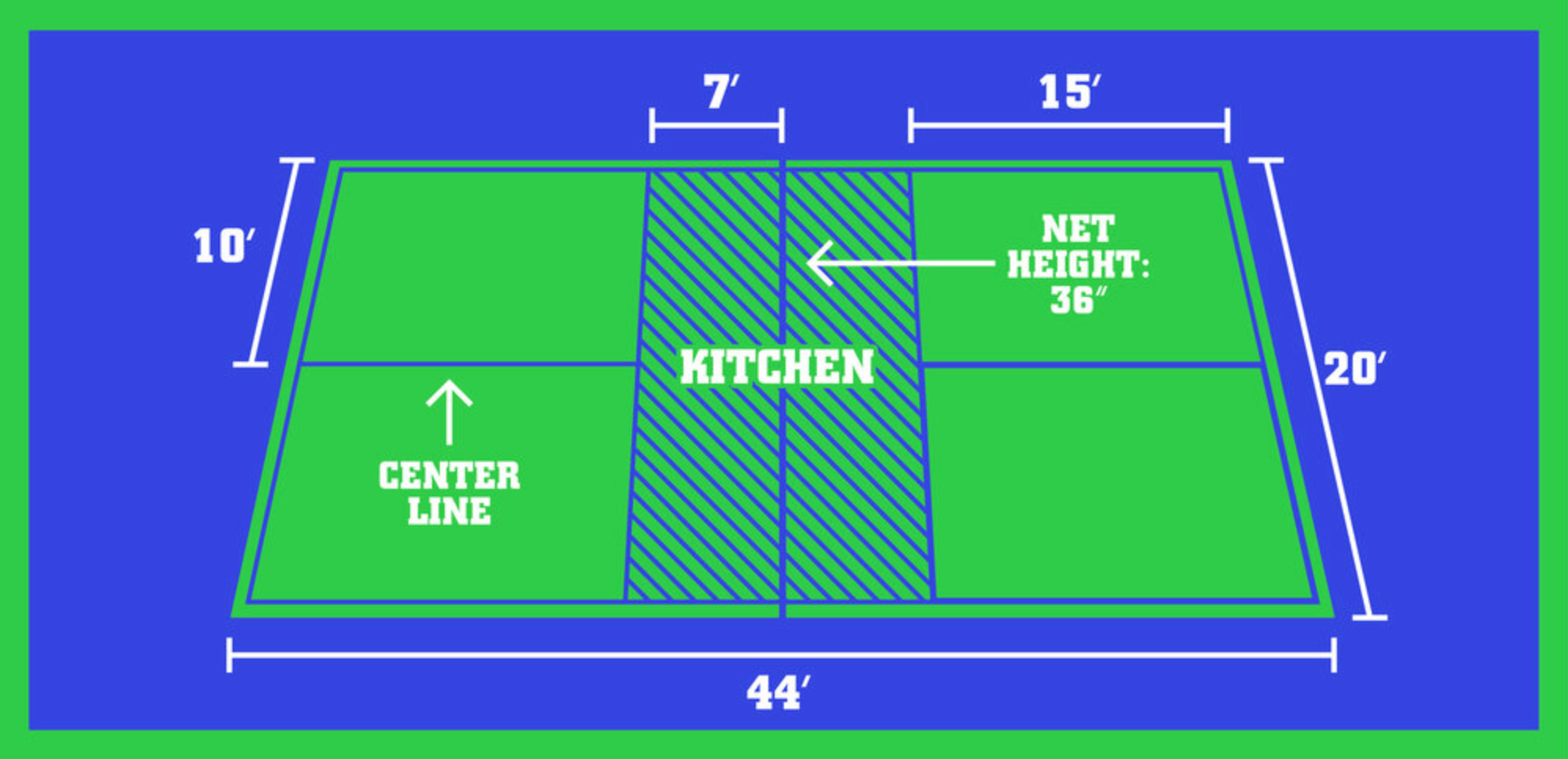
Kitchen: Also known as the "non-volley zone," a seven-foot area on both sides of the net where players cannot volley the ball.
J for Junior
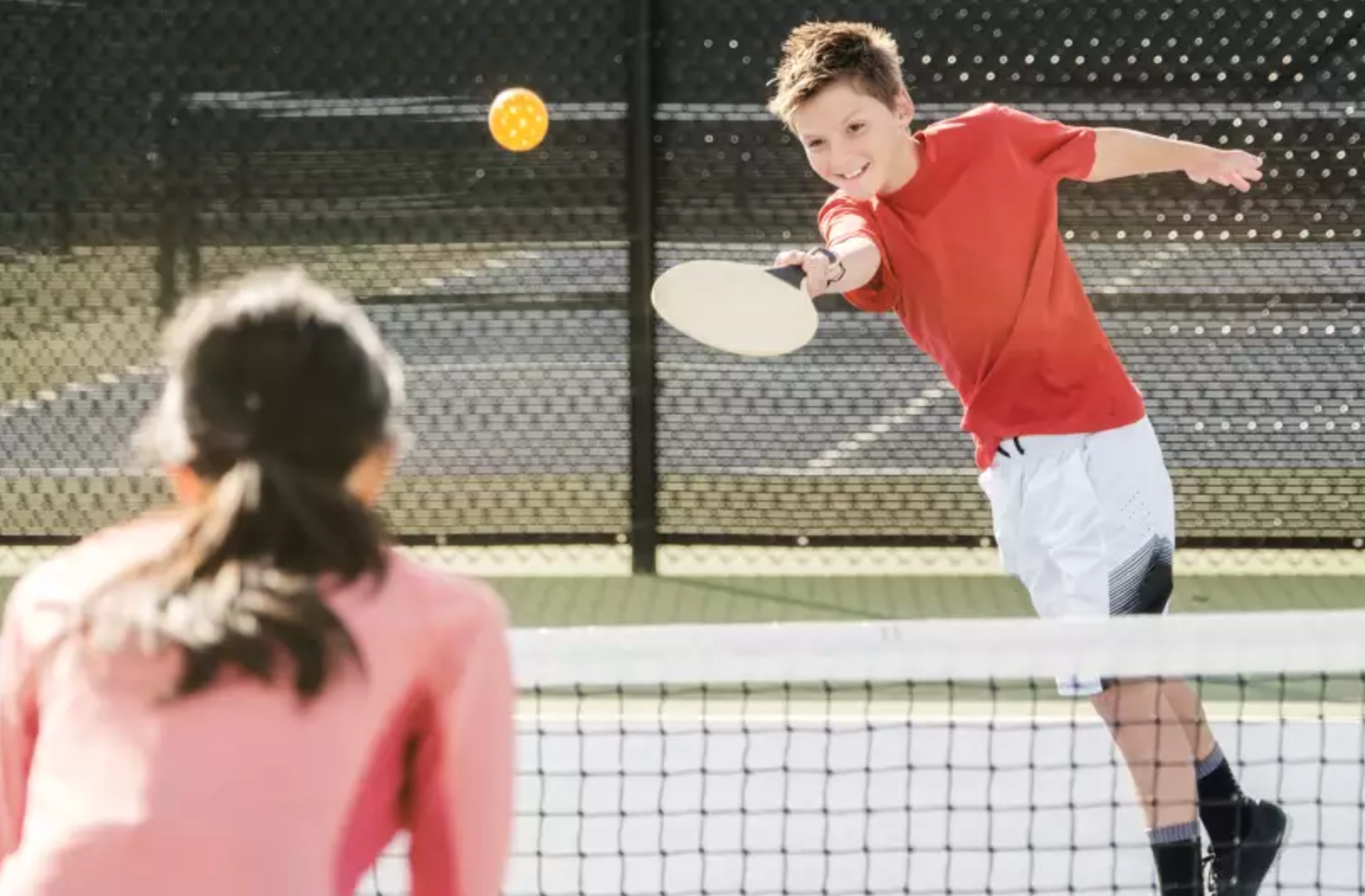
Junior: A player who is typically under a certain age threshold and participates in the sport at a youth level. The exact age range for juniors can vary depending on the organization or tournament, but it generally includes players who are younger than 18 years old. Junior players often have their own divisions or categories in tournaments or events, allowing them to compete against others in their age group. Junior pickleball provides an opportunity for young players to develop their skills, compete, and enjoy the sport at their level.
L for Lob
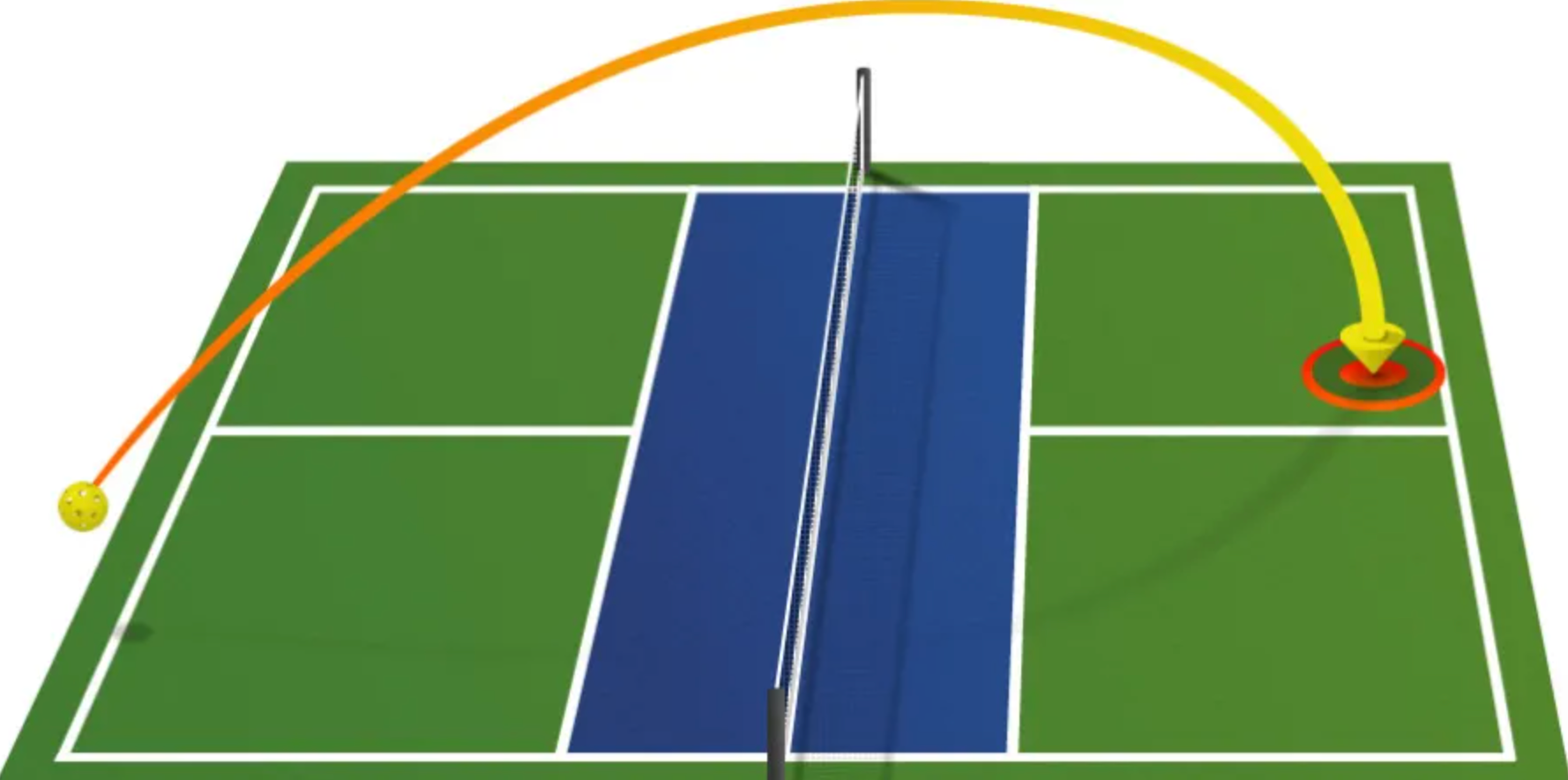
Photo Credit: Pickleball.tips
Layout: A defensive play in which a player lays his or her body down on the court horizontally in order to hit a shot.
Let Serve: A serve that touches the net but still lands in the correct service court, resulting in a replay of the point.
Line calls: The judgments made by players regarding whether a ball lands in or out of the court. When a shot is hit near the lines of the court, players must make a decision based on their observation of where the ball lands. If the ball is determined to have landed on or inside the line, it is considered "in" and the point continues. If the ball is deemed to have landed outside the line, it is called "out," and the opposing player or team is awarded the point. Line calls require attentiveness and fair judgment from the players, and there can be instances of disagreement where players may request a second opinion or use officiating resources, if available, to resolve any disputes.
Lob: A high-arching shot that travels deep into the opponent's court, often used to reset the point or force the opponent back.
M for Midcourt
Midcourt: The central area of the court between the non-volley zone (kitchen) and the baseline. It is the space where players often position themselves during rallies, allowing them to be in a balanced position to both defend and attack. The midcourt is an important strategic zone where players can respond to shots from various angles and make decisions about positioning, shot selection, and movement on the court. Players in the midcourt have the flexibility to move forward towards the net or backward towards the baseline, depending on the situation and the opponent's shots.
N for Non-Volley Zone
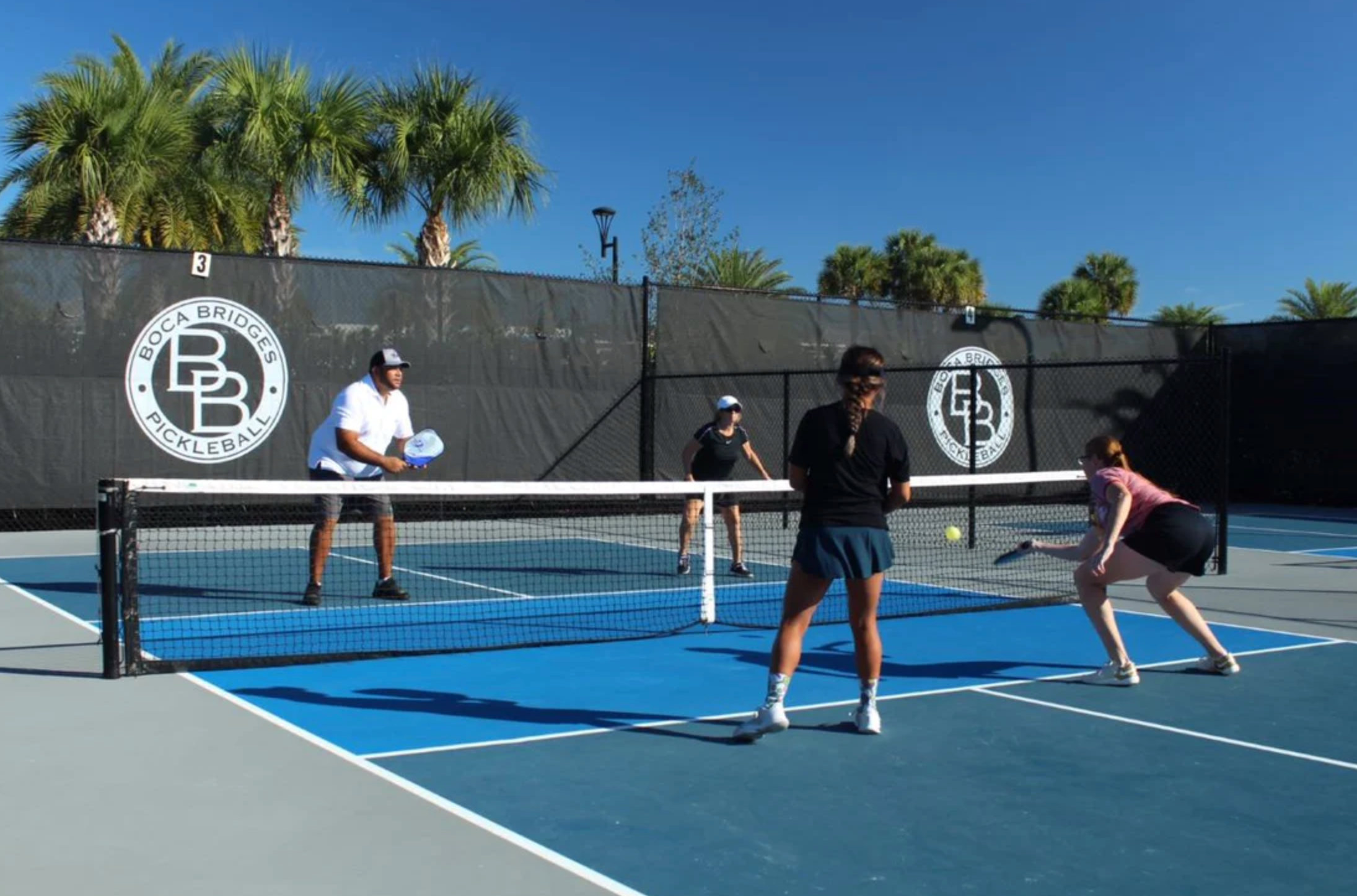
Net Game: A style of play that focuses on volleys and shots near the net to maintain control and pressure the opponents.
Non-volley zone (NVZ): Also known as the "kitchen," this is the seven-foot area on both sides of the net in pickleball. It extends from the net to a line that is parallel to the net, and it prohibits players from hitting the ball out of the air (volleying) while standing within this zone. Players are allowed to enter the non-volley zone but must let the ball bounce before making contact with it. The non-volley zone is designed to promote fair play, minimize overly aggressive shots near the net, and encourage strategic shot placement and soft play in that area of the court.
O for Out of Bounds
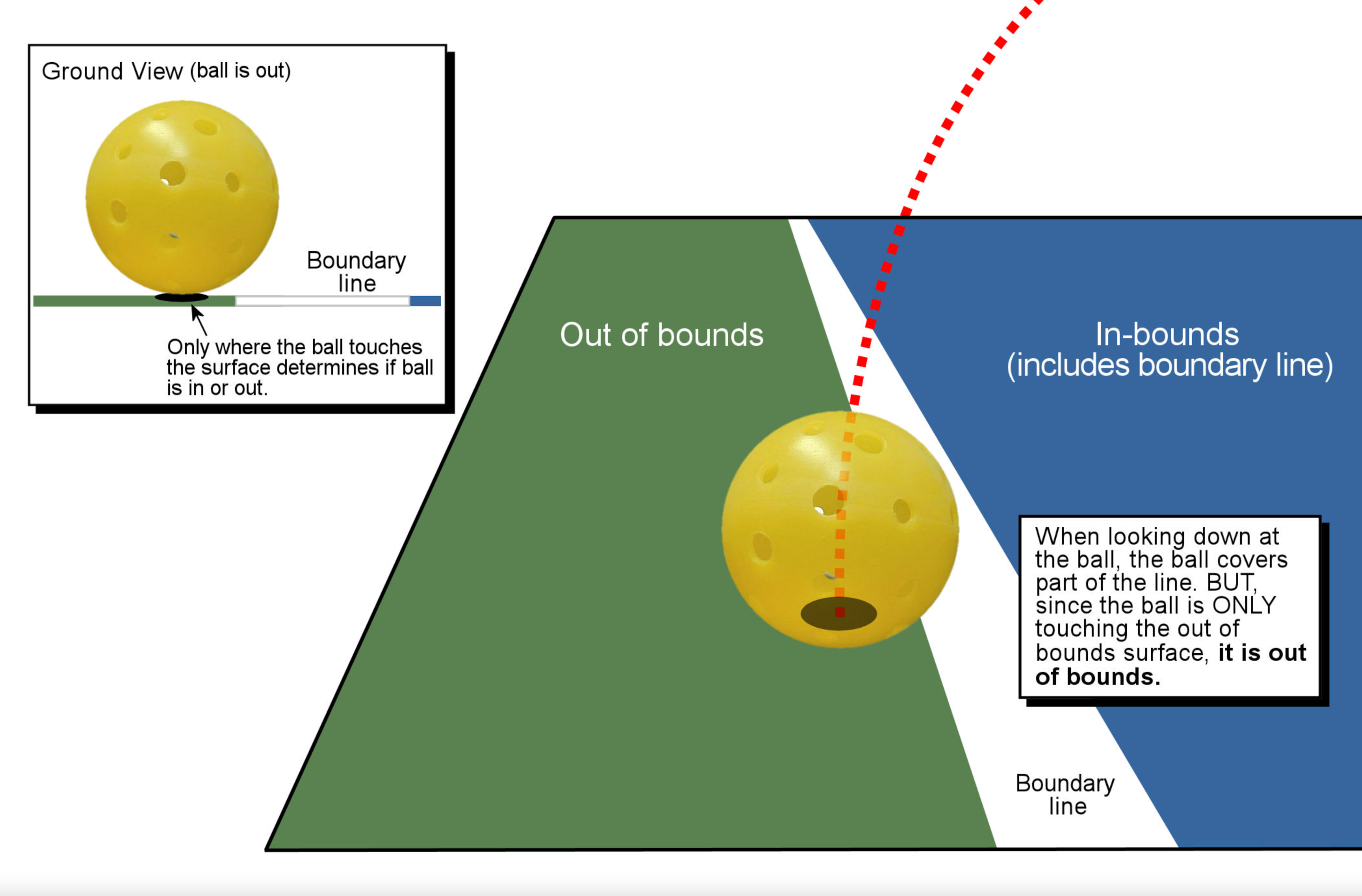
Off-Pace Shot: A shot hit with less power, often used to disrupt the opponent's rhythm or throw off their timing.
On the Fly: Hitting the ball before it bounces, usually with a volley or an overhead shot.
Open face: Refers to the positioning of the paddle face during a shot. When the paddle face is "open," it means that the angle of the face is more perpendicular to the ground or tilted slightly upwards. This positioning creates a larger, more open striking surface. An open face is often used for shots that require more lift, such as lobs or shots with significant topspin. It allows players to generate more height and spin on the ball, making it useful for shots that need to clear the net or curve sharply.
Out of Bounds: When the ball lands outside the boundaries of the court, resulting in a point for the opposing team.
Overhead shot: A shot where a player strikes the ball while it is above their head and in a descending trajectory. This shot is typically executed when the ball is high in the air, such as after a lob or to return a high bouncing ball. The overhead shot is commonly performed with a swinging motion, using both hands on the paddle, and it is aimed to hit the ball with power and accuracy towards the opponent's court. It is an offensive shot that allows players to regain control of the point and put their opponents on the defensive.
Overhead slam: An aggressive and powerful shot where a player forcefully strikes the ball from an overhead position, aiming to hit it downwards with significant speed and force. It is typically executed when the ball is high in the air, such as after a lob or when presented with an opportunity to attack a high bouncing ball. The overhead slam is characterized by a strong swinging motion and an intent to finish the point with an emphatic winner. It requires good timing, technique, and explosiveness to execute effectively. The overhead slam is often used to put pressure on the opponent and to score points with authority.
P for Paddle

Paddle: A flat, solid racket-like instrument with a handle and a paddle face. It is typically made of materials such as composite materials (e.g., graphite, fiberglass) or wood. The paddle face is the part of the paddle that comes into contact with the ball. Paddles vary in size, weight, and grip circumference, allowing players to choose a paddle that suits their playing style and preference. The paddle is an essential tool in executing shots, providing control, power, and spin in the game of pickleball.
Painting the line: When the ball lands directly on the sideline (or court boundary line).
Passing shot: A shot played by the non-volleying player (often referred to as the "baseline" player) to get the ball past the opposing player at the net. It is typically executed when the opponent is positioned near the net, attempting to volley or block the shot. The passing shot is aimed to be hit with pace and precision, either down the sideline or cross-court, to prevent the opponent from reaching the ball and score a point. It is a strategic shot used to neutralize the net player's advantage and create scoring opportunities for the baseline player.
Permanent object: Any obstacle or structure that is considered a permanent part of the court and cannot be moved or adjusted during play. Permanent objects include features such as the net posts, fencing, poles, walls, or any other fixed elements within or around the court. These objects are treated as part of the playing environment and should not be interfered with or used for strategic advantage. Players must be mindful of permanent objects to avoid collisions or obstruction during the game.
Pickle: A term used when a player is caught in the middle or unable to decide whether to hit a forehand or backhand shot.
Pickleball Paddle: The specialized paddle used to hit the pickleball, typically made of composite materials or wood.
Pickled: The equivalent of getting "skunked" in other sports. It refers to a player or team not scoring any points in a given game, thus losing 11-0.
Pickledome: The main court or center court where the championship match or significant matches are played. It is akin to the "center court" in tennis, serving as the primary court for showcasing high-level matches and determining the tournament's winner.
Pickler: A term that can be used to refer to a person who plays pickleball. It is a playful and colloquial term that highlights someone's involvement or enthusiasm for the sport. A pickler is simply an individual who enjoys playing pickleball and actively participates in the game.
Poach: When a player moves from their original position to intercept a ball intended for their partner.
Power Serve: A strong and fast serve aimed at putting the receiving team on the defensive from the start of the point.
Punch shot: A quick and compact shot executed with a short backswing and a sharp forward punch-like motion. It is typically used when the ball is low or close to the player's body, and a full swing may not be feasible. The punch shot involves a quick extension of the arm and a firm contact with the ball, providing control and accuracy in situations where a softer touch or a precise placement is required. The punch shot is commonly employed when the player is near the non-volley zone (kitchen) and needs to keep the ball low and within the opponent's reach.
Putaway: A shot that is hit with enough power and precision to end the point by making it difficult for the opponent to return.
R for Rally

Racket (or Raquet): Often used interchangeably with "paddle" to refer to the equipment used to hit the ball. While some may refer to it as a racket, the more commonly used term in pickleball is "paddle." The paddle or racket is a specialized instrument with a handle and a face that is used by players to strike the pickleball during the game. The paddle is available in various sizes, shapes, and materials to suit individual preferences and playing styles.
Rally: A series of shots exchanged between players in continuous play until the point is won or lost.
Rally Scoring: A scoring system where points can be won by either team, regardless of who is serving.
Receiver: The player or team that is receiving the serve. The receiver is the non-serving side, positioned on the opposite side of the net from the serving side. Their role is to return the serve and engage in rallies to earn points. The receiver's objective is to receive the serve effectively and strategically place their shots to challenge the serving team and potentially win the point.
Ready Position: The stance and positioning a player takes to be prepared for the opponent's shot.
Replays: Refers to a situation where the point is replayed without either team scoring a point. There are various instances in which a replay can occur during a game. Some common reasons for a replay include:
-
Let Serve: If the serve touches the net and lands within the correct service court, it is considered a let serve, and the point is replayed.
-
Fault Serve: If the server commits a fault, such as stepping on or over the baseline during the serve, it results in a fault, and the serve is replayed.
-
Hindrance or Interference: If there is interference or an external factor disrupts the play, such as a ball rolling onto the court or a player crossing into the opponent's court, a replay is typically called to ensure fairness.
-
Equipment Failure: If a player's equipment (such as the paddle) breaks during a point or any other equipment malfunction occurs, a replay is often granted.
-
Simultaneous Faults: If both the serving team and the receiving team commit a fault at the same time, such as both stepping into the non-volley zone or touching the net, a replay is typically given.
A replay allows the point to be played again without any team gaining an advantage or winning the point.
Reset: A shot or strategy used to regain control of the point after being on the defensive or under pressure. Also could refer to when players are able to stop a hard or fast rally and slow the rate of play down.
S for Sideline
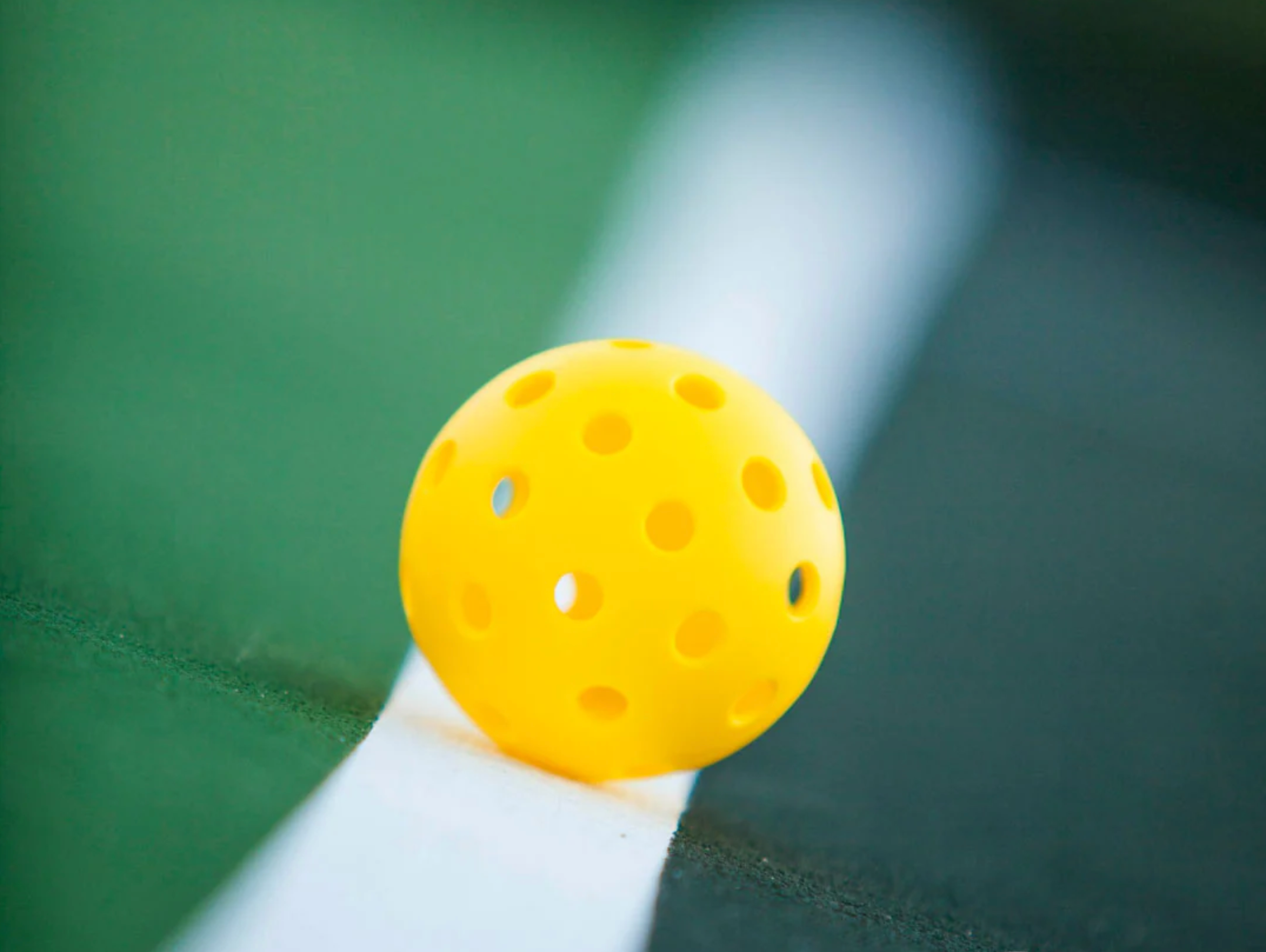
Scorpion: A type of defensive shot where a player dives forward and extends their legs behind them to make a shot with the heel or sole of their foot. The player's body arches like the tail of a scorpion, hence the name.
Second serve: The opportunity given to the server to serve again after committing a fault on their first attempt. If the server's first serve fails to land in the correct service court or violates any other serving rule, it is considered a fault. As a result, the server is allowed a second serve to try again without penalty. The second serve provides an opportunity to correct the mistake and continue the service game. If the second serve also results in a fault, it leads to a point for the receiving team.
Serve: The initial shot that begins a rally, where the server hits the ball diagonally into the opponent's service court.
Server number: the serving rotation or order of players within a doubles match. Each player on a doubles team has a designated server number, either "1" or "2," which determines the order in which they serve during the game.
Service court: the specific area on the court where the server must stand while serving the ball. The service court is a rectangular section on each side of the net, divided into two halves: the right service court and the left service court.
Shadowing: A defensive strategy where a player closely mirrors the movement and positioning of their opponent on the opposite side of the net. When shadowing, the player aims to anticipate and mimic the opponent's shots, footwork, and court positioning to be in an optimal defensive position to counter their shots effectively.
Side out scoring: The current scoring system used in pickleball where a player needs to be serving in order to score any points.
Sideline: The boundary perimeter the court. The sidelines mark the outer boundaries of the playing area and separate the playing zone from the out of bounds area.
Side Out: When the serving team loses the serve and the receiving team gains the opportunity to serve.
Side Spin: Spin applied to the ball that causes it to curve or bounce in a sideways direction.
Singles: a format of play where two players compete against each other, one-on-one. It is a variation of the game where there is only one player on each side of the court, as opposed to doubles play where two players are on each side.
Slice: a shot played with a sideways or diagonal motion that imparts sidespin on the ball. It involves brushing the paddle across the back of the ball at an angle, causing it to spin in a sideways or curving trajectory.
Smash: a forceful and aggressive overhead shot aimed to hit the ball with power and speed. It is typically executed when the ball is high in the air, such as after a lob or to capitalize on a weak defensive shot.
Split stance: A foot positioning technique used by players when preparing to hit a shot. In a split stance, the player's feet are positioned with one foot slightly in front of the other, creating a split between the feet. The front foot is typically the foot on the same side as the player's dominant hand (right foot for right-handed players, left foot for left-handed players).
Stack: A positioning strategy where one player stands behind the other, often used to maximize cross court coverage and communication.
Stack Formation: A doubles positioning strategy where both players stand on the same side of the court, typically used to exploit certain matchups or strategies.
Stroke: The technique or motion used to strike the ball during gameplay. It encompasses the various types of shots and swings employed by players to hit the pickleball. Strokes can include forehand shots, backhand shots, volleys, overheads, drop shots, and more.
T for Third Shot Drop

Technical foul: An officiate ruling that may result from certain unsportsmanlike or rule-violating behaviors can result in penalties or sanctions
Third Shot Drop: The shot that is hit by the serving team as their third shot, usually a soft drop shot that aims to get closer to the net.
Topspin: A type of spin applied to the ball that causes it to rotate forward, resulting in a downward trajectory after bouncing.
Touch Shot: A shot hit with finesse and delicate touch to place the ball precisely in a specific location.
Transition Area: The space on the court between the non-volley zone and the baseline, where players often move to adjust their position during the rally.
Two-Bounce Rule (or Double-Bounce Rule): A rule that states that each team must allow the ball to bounce once on each side before they can volley it.
U for Underspin
Unattackable ball: A drop shot, dink, or reset shot that doesn't bounce high enough to be attacked (typically a shot that has a bounce height lower than the net).
Underspin: Also known as backhand slice or slice, underspin refers to a spin that causes the ball to rotate forward and downward as it moves through the air. Shots with underspin have a flatter trajectory and tend to skid off the court upon landing, making them more challenging to return. Underspin is often employed to keep the ball low over the net, generate defensive shots, or add variation to the gameplay.
V for Volley
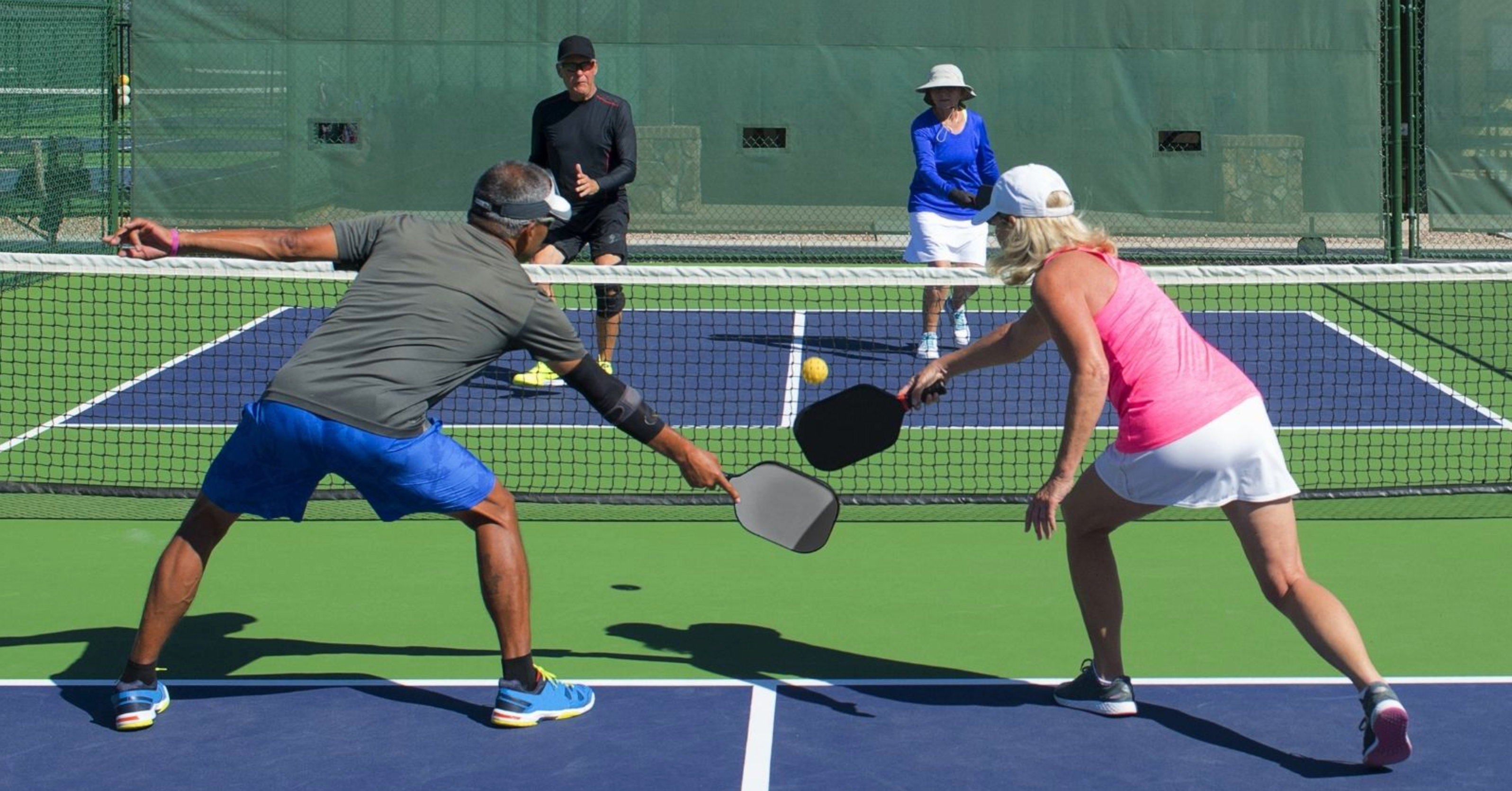
Volley: Hitting the ball out of the air without letting it bounce on the ground.
Volley llama: A playful term used to describe a fault where a player hits a volley shot while standing inside the non-volley zone (kitchen). The non-volley zone, also known as the kitchen, is a designated area near the net where players are not allowed to volley the ball. Violating this rule by hitting a volley shot from within the non-volley zone results in a fault and the loss of the point.
W for Wrist Snap
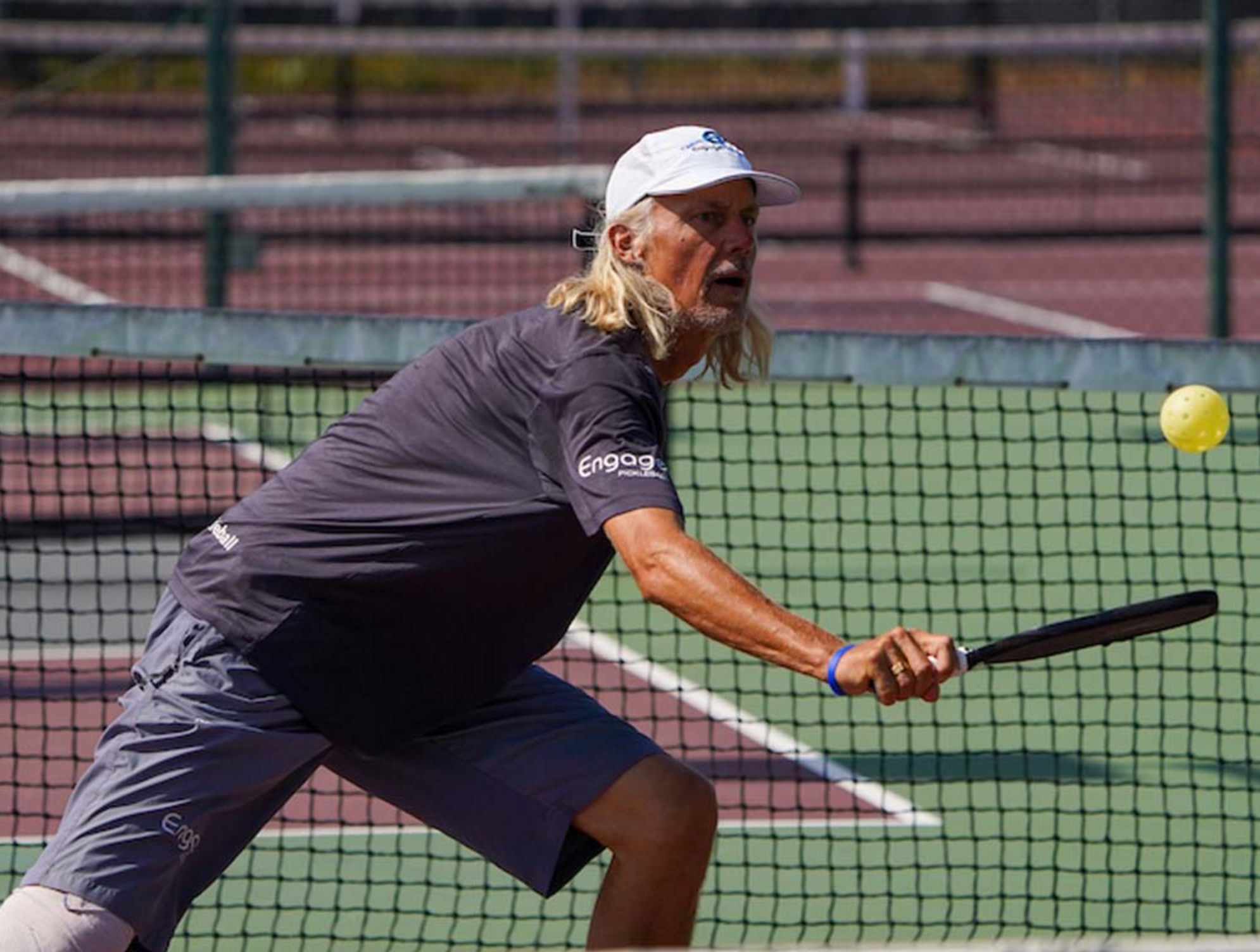
Whiff: A swing and a miss, where a player attempts to hit the ball but fails to make contact.
Wrist Snap: A quick and controlled movement of the wrist used to generate spin or power when striking the ball.
DISCLAIMER: This list is comprehensive at time of writing; at the rate PICKLEBALL is growing, there will likely be a minimum of three new related terms by the time you finish reviewing this list.

